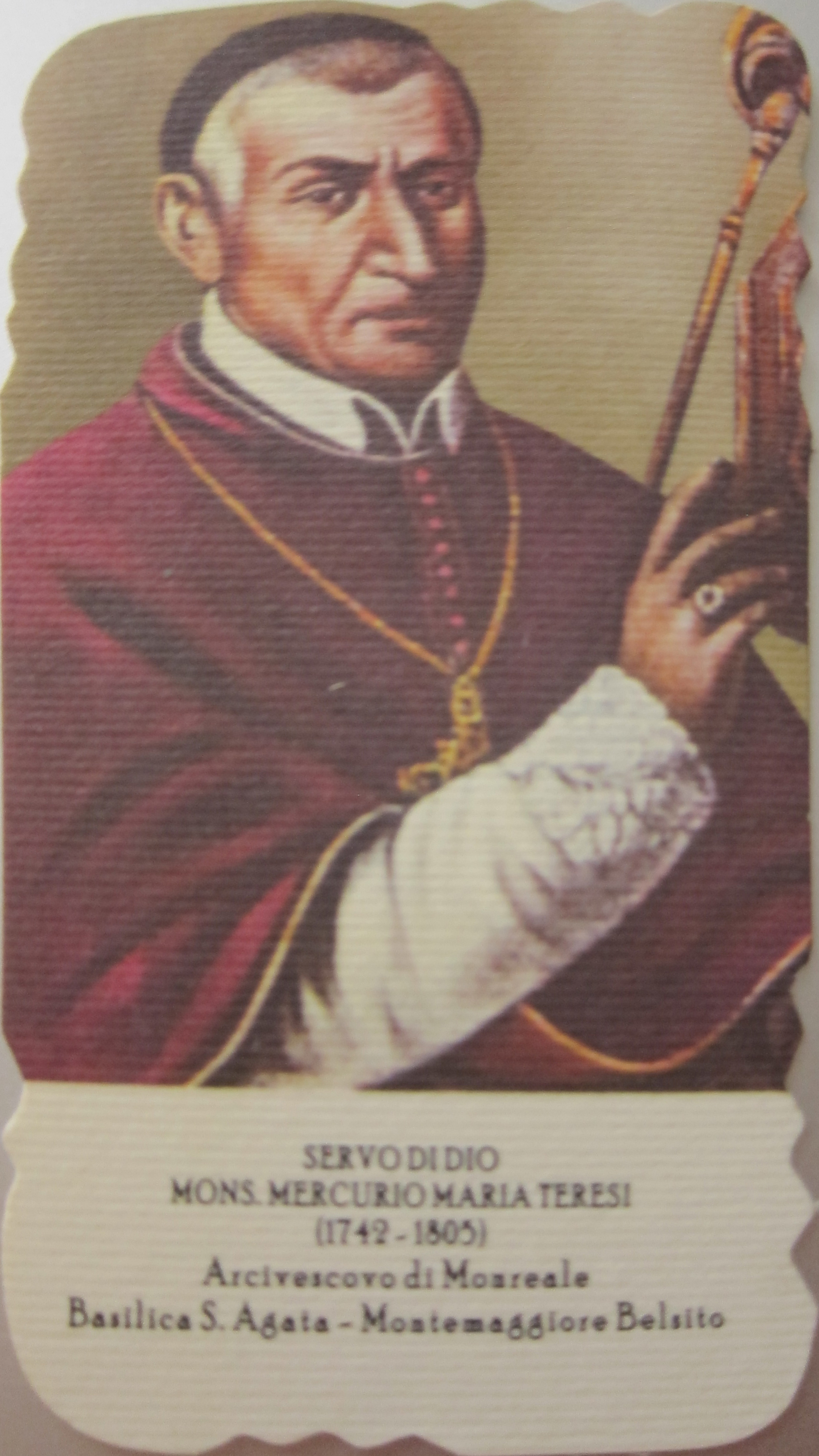Well, the NY State background checks arrived today. Despite noting that they needed to be suitable for apostille, both in the cover letter and on the application, they arrived unsigned. We're sending them off the the NY Secretary of State with a letter asking if they can apostille them and if not to please either call the NY State Police or send us a letter with clear instructions as to what they need in order to apostille a documents. It appears that writing in every possible margin of a form is not enough for people to issue signed background checks. Only TN sent them right (well, except for a spelling mistake).
Background checks from TBI arrived today. Everything was perfect – signatures, seals, notarized statement – except that they spelled my wife's name wrong on the address lines (Palmer instead of Palmeri). So we sent them a letter asking them to correct and resend.
The background check arrived today from Indiana. All it says is "A thorough search of our files by NAME, DATE OF BIRTH, SEX, RACE, and FINGERPRINTS DOES not reveal a criminal history record …"
I forwarded it on to the Indiana Secretary of State for an apostille, which fortunately is free (unlike most states).
Unfortunately, the background check did not have a signature or a seal on it, so I don't know if it will be accepted for an apostille. So in parallel, I wrote the Indiana State Police again for another copy of the background check, hopefully with a signature and a seal this time.
As I was looking through some of my Burke records, I realized that I had my great-grandfather's social security application. This clearly lists his mother as "Anna Brady". His birth and death certificate say "Maria Brady". I am betting that her name was probably "Maria Anna Brady" but went by Anna Brady. I'm betting that she first married Henry Howard, who either died or she divorced, and then married Anthony Burke. Henry Howard was Amelia Howard's brother. She was mother of Bishop Burke. Anthony Burke was Joseph Burke's brother. He was the father of Bishop Burke. Anthony Burke's death certificate listed his deceased wife as "Anna Howard." So here's my tentative, revised Burke family tree. My great-grandfather and Bishop Burke were first cousins by blood (Burke) and step cousins by marriage through Henry Howard.
.jpg)

I learned that I could possibly order the complete military records for my grandfather. He fought in the Pacific during World War II as a glider pilot in the Army, later became part of the Air Force, and retired a Captain or Major I think. I have a few photos and some basic outline of his military career. Since my mother passed away, I checked to the National Archives to see if and how I could order my grandfather's records. This is their response:
Thank you for your inquiry. You may download a form SF-180, complete it, and mail it, along with a copy of a record of death or obituary, to the National Personnel Records Center in St. Louis, MO. You can download the form at: http://www.archives.gov/veterans/military-service-records/standard-form-180.html. On the form we suggest that you note that you would like copies of all records in the file.
Please note that a 1973 fire at the records center destroyed a large number of files. Hopefully, your grandfather's records survived.
We hope this information will be of assistance.
Sincerely,
The National Archives at Chicago
A jure matrimoni application requires "police clearance or certificate of criminal records issued by the central authority of each state of which the applicant has been a resident since the age of 14, accompanied by a translation into Italian."
Today, my wife obtained her finger prints from the Nashville Police Department ($12).
We need to pay for background checks: NYS Division of Criminal Justice Services ($60.75), Tennessee Bureau of Investigation ($29.00), Indiana Digital Finger Prints ($12), Indiana State Police Background Check ($10), and FBI ($18.00).
I found the marriage certificate for Emmanuel de Guehery and Marion Cuthbert, my great-great-grandparents. Both are from Chalk River. Emmanuel was born in Waterloo County, Ontario and was a fireman for the railroad. His parents were Rudolph and Goddlikin de Guehery. Marion was born in London, England. Her parents were Thomas and Margaret Cuthbert. Their marriage was 25 February 1884 in Pembroke. They were Presbyterian.
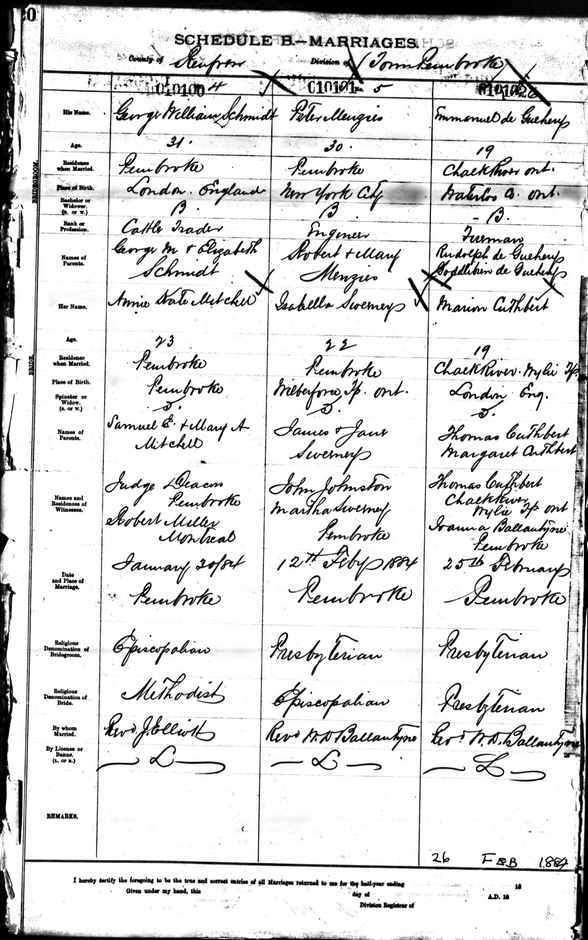
Here is a story about the 150th Pennsylvania Volunteers which I got from here: http://www.pa-roots.com/pacw/infantry/150th/150thorg.html
Isaac Zellers, my wife's great-great-great-grandfather, served in the 150th and was injured during the Battle of Gettysburg. He spent the rest of the war in the hospital.
The companies of the 150th were recruited as follows:
Company A – Philadelphia
Company B – Philadelphia
Company C – Crawford County
Company D – Union County
Company E – Philadelphia
Company F – Philadelphia
Company G – M'Kean County
Company H – Crawford County
Company I – Crawford County
Company K – Crawford County
They rendezvoused at Camp Curtin, where, on the 4th of September, a regimental organization was effected with the following field officers:
Launghorne Wister, of Philadelphia, Colonel
Henry S. Huidekoper, of Crawford County, Lieutenant Colonel
Thomas Chamberlin, of Union County, Major
Colonel Wister had served with distinction in the battle of Dranesville, and in the entire Peninsular campaign, in command of a company of the old Bucktails; Lieutenant Colonel Huidekoper had applied himself closely to the study of tactics, and to squad drill, during the year previous, at Harvard University, where he had graduated in June, and Major Chamberlin had served through the Peninsular campaign, as Captain in the Fifth Reserves, a regiment not inferior in soldierly qualities to the Bucktail.
When the Major received his commission, he was lying in hospital at Baltimore, of a severe wound, received at Charles City Cross Roads, but learning that the enemy was invading Maryland, instead of looking for his new command, he sought out his old regiment, and fought with it through the fiery battles of South Mountain and Antietam. It will thus be seen that the field officers were well fitted for their duties.
Soon after its organization at Harrisburg, it proceeded to Washington, and was immediately assigned to duty as guard, in and about the city. Companies D and K being stationed at the Soldiers' Home, the summer residence of the President, where they were drilled by a field officer, and Company A at the Soldiers' Rest, near the Baltimore depot, where, later, it was joined by Company D. Company K continued to act as the President's body guard, until after the assassination of Mr. Lincoln, and until the end of its term of service. A brief sketch of this service will be found at the close of the regimental narration.
During the pleasant weather of the fall, the balance of the regiment was drilled at Meridian Hill. Before mid-winter, nearly all the companies were taken away for guard duty, at various points in and around the city, Lieutenant Colonel Huidekoper, in the meantime, served on a General Court Martial, and Major Chamberlin was detailed on the 23d of October, as commandant of Georgetown, where he remained until his regiment was ordered to the field.
About the middle of February, 1863, the Bucktail troops moved to Belle Plain, where a brigade was formed, consisting of the One Hundred and Forty-ninth, One Hundred and Fiftieth, and One Hundred and Forty-third Pennsylvania regiments, under command of Colonel Stone, which became the Second, of the Third Division, First Corps.
On the 21st of April, the regiment marched with the division to Port Conway, opposite Port Royal, where a feint of crossing was made, returning to camp on the 23d, after a fatiguing march. This expedition was the prelude to the grand campaign about to open, and on the 28th the whole army was in motion, the First Corps moving to Polock's Mills, and on the following day to the bank of the river, where portions of the command were, subjected to a vigorous shelling from the enemy's batteries on the opposite shore, but from which the regiment suffered no loss.
Chancellorsville
On the 2d of May, the corps made a forced march to Chancellorsville, taking position on the extreme right of the line, the brigade holding the left of the corps, joining with the Fifth Corps, the regiment standing, upon the right of the brigade. Pickets were immediately thrown out, advancing cautiously through the thickly wooded ground, uncertain as to the strength and whereabouts of the enemy. Many stragglers from the Eleventh Corps, which had occupied this part of the field on that evening, but from which it had been driven by the impetuous charge of Stonewall Jackson, were picked up, and some prisoners taken.
At daylight, strong breast-works were thrown up, and here the corps remained, without being actively engaged, until the close of the battle. On the 6th, with the rest of the farm, the regiment re-crossed the Rappahannock, and went into camp with the division at White Oak Church, where it remained, with slight changes, until it marched, about the middle of June, on the Pennsylvania campaign.
Gettysburg
At Gettysburg, on the 1st of July, it met the enemy, and really fought its first battle, winning a reputation for valor that will be imperishlable.
"The One Hundred and Fiftieth Regiment," says the report, " came upon the field of battle near Gettysburg, about eleven P.M., July 1st, 1863. We halted in front of the Seminary, to the west of the town, and throwing off our knapsacks, moved forward about half a mile to a position behind the crest of a hill, our right near a large barn, our left joining the Iron Brigade, consisting of Wisconsin and Michigan troops. The ground was gently rolling and open, the only shelter being a slight fence. We had not been long in position before the enemy began to shell us heavily, when, finding that they produced little effect in front, they opened a new battery on our right flank, and began an enfilading fire upon us. Our right flank was exposed, as our brigade held the angle of the two fronts of our army, and the new Whitworth projectiles from this battery killed two and disabled three in company C. We then shifted our position so as to obtain a partial shelter from the barn, before mentioned, the One Hundred and Forty-third, and One Hundred and Forty-ninth, meanwhile, being established in a dug-out road, fronting towards the north, and forming a right angle with the One Hundred and Fiftieth, which fronted westward. The enemy continued to shell our position until about two P. M., without, however, disabling more than ten or twelve men. Company B, Captain Jones, which had been sent forward as skirmishers, was, meanwhile, actively engaged in our front, sustaining considerable loss. About this time, Colonel Stone1, commanding the regiment, having gone forward, to reconnoitre, was hit in the hip and arm by two balls from the enemy's skirmishers and was carried from the field into the barn.
"Colonel Wister then assumed command of the brigade, and Lieutenant Colonel Huidekoper of the regiment. Soon after, a strong force of rebel infantry advanced from the north on our right, and we then changed front forward, so as to come into line with the other regiments of the brigade. This movement was accomplished rapidly, though under a heavy fire. The enemy now approached within less than fifty yards, when they were staggered by our fire, and halted, exchanging shots with us for several minutes. A new line of rebels was seen approaching from the west, against the letf, at a distance of half a mile, and Colonel Wister here ordered a charge, to free us from our old assailants, before the new ones were upon us. This movement was entirely successful. The enemy, who had suffered terriblly from our fire, gave way at once and fled in confusion. The danger of injuring their own troops being now removed, the rebel batteries opened upon us with terrible effect, and the infantry fire from the line advancing upon our left became also very severe. In view of this, Colonel Wister gave orders to change front to the rear, so as to resume our original position. This movement was successfully and rapidly performed, though with a terrible loss."
The colors of the One Hundred and Forty-ninth had been placed at a little distance to draw the enemy's fire, and had been captured by them in the advance spoken of, but were re-captured by a squad of the One Hundred and Fiftieth in this charge. The One Hundred and Forty-ninth then reinforced us in our new line, and we were in position none too soon, as the advancing lines of the rebels were soon upon us. Our men were partially sheltered by a port-and-rail fence, from behind which we poured so severe a fire upon the enemy that their line also gave way. After retreating a short distance, however, they moved off by their right flank, and fixed themselves in a thick wood in front of the Iron Brigade on our left. Colonel Wister was wounded in the face during this encounter, but did not leave the field. No charge was made from this time, a quarter before three, for a considerable interval, but a very heavy artillery and infantry fire was kept up upon us.
During this time, Lieutenant Colonel Hiuidekoper was severely wounded in the right arm, which has since been amputated, and was compelled to leave the field. Adjutant R. L. Ashhurst was wounded in the shoulder, Lieutenant Gilbert B. Perkins in the thigh, and Lieutenant Chancellor, Jr., had his leg almost torn off by a solid shot.
Not long after three P. M., our whole line began to give way. Our brigade, however, had no orders to retreat, and continued to hold its ground for some time, when, finding ourselves almost surrounded by the enemy, we at last fell back, slowly, under a very severe fire. The Iron Brigade had fallen back some time before ours, and had formed a new line on the crest of the next ridge, midway between the Seminary and the front. Here we again halted, and withstood the enemy's attacks for some time; but the line giving way on all sides, and finding ourselves again becoming surrounded, we were compelled again to fall back.
On our retreat, we found one of our batteries on which the enemy was directing a heavy fire, and which they were preparing to assault. Here the remainder of our men again rallied in an orchard, and succeeded in repelling a desperate rebel charge on the battery. We held this position, though the rest of the line had given way, until the guns of the battery were limbered up, horses hitched, and the commanding officers said they were ready to move to a place of safety. An aid rode up soon after, with orders for us to retreat through the town to the new line formed on the south side. This we proceeded to do; but our retreat had been so long delayed, that many of our men were captured in the streets of Gettysburg, the enemy having closed in both on our right and left.
"" Up to this time," says Major Chamberlin, " our colors were safe. The Color Sergeant had been killed in the orchard, and all the color guard had been killed or wounded, except one, some of them receiving three or four balls. The colors were held by Corporal Gutelius, of company D, who carried them to the town, and insisted on keeping them, although he was slightly wounded. Stopping a moment to rest, the rebels were on him, and he was shot dead with the colors clasped in his arms. This is the same flag which was presented to Jefferson Davis, with a flourish of trumpets, at the request of a North Carolina Lieutenant, who, it was alleged, with a handful of sharp-shooters, scattered a Pennsylvania regiment, and captured their colors; but in doing so, was himself mortally wounded. The flag was found with Jefferson Davis' effects, when he was overhauled in Georgia, in the spring of 1865. "This flag was held by the Secretary of War, until October 25th, 1869, when it was transmitted to the Adjutant General of this State, with a letter, in which he says " I am directed by the President to send herewith, the flag of the One Hundred and Fiftieth Pennsylvania Volunteers, said to have been captured at Gettysburg, and re-captured in the baggage of Jeff. Davis."
It is now deposited with the other tattered ensigns of the State, in the Capitol at Harrisburg."
Upon arriving at the Cemetery, it was re-formed, and rested in line during the night. On the following day it was held in reserve, in rear of Cemetery Hill, and at night, was sent with the One Hundred and Forty-ninth to rescue some pieces of artillery of a regular battery, which had been lost. Two guns and four caissons were secured, and brought off, the regiment remaining on the field during the night, and retiring in the morning with only small loss. It was under a severe fire of artillery in the afternoon, and was held in readiness to charge, when the enemy made his last attack a little to the left of the position which it held; but before the order to advance was given, he had been most disastrously repulsed, and the battle was at an end.
The regiment went into the battle with seventeen officers, and about four hundred men. Of these, forty-three were killed, one hundred and thirty-eight wounded, and sixty-nine taken prisoners. Lieutenants E. B. Weidensau, Charles P. Keyser: and Henry Chancellor, Jr., were of the killed; Colonel Wister, Lieutenant Colonel Huidekoper, Major Chamberlin, Adjutant Richard L. Ashhurst, Captains William P. Dougal, John W. Sigler, and Lieutenants Gilbert B. Perkins, C. W. Sears, and Miles F. Rose, of the wounded, and Captain Cornelius C. Widdis, Henry W. Gimber, and Lieutenants John Q. Carpenter, and Joseph Chatburn, were of those taken prisoners. But two officers remained, and one of these was wounded. The companies uniformly lost heavily.
Two incidents connected with this regiment, at the opening, of the battle, which are related by Major Chamberlin, are worthy of commemoration.
" Soon after taking up our line in the orchard," says he,'" an old gentleman approached us from the direction of the town, dressed in a blue, swallow-tailed coat, and high silk hat, rather worse for the wear, carrying a musket, and asked me if he could be allowed to fight with our regiment. I answered that there could hardly be any objection, but referred him to Colonel Wister, who stood near. On repeating his question to the Colonel, Wister asked him if he could shoot.'Oh, yes,' said the old gentleman.'But where are your cartridges,' asked the Colonel' Slapping his hand on his pantaloons pocket, he replied,' I have them here.''Certainly you can fight with us,' said the Colonel,' and I wish there were many more like you.' The Colonel, however, told him that he had better go into the wood to our left, as he could do more damage there, and be less liable to be hit. The old man went into the wood, and joined one of the regiments of the Iron Brigade, and history will preserve the memory of old John Burns, as long as it tells the story of the great battle of Gettysburg." It may be added, that he fought heroically, and was wounded in the side and leg, and left insensible upon the field. He was finally rescued, and taken to his home. He survived his injuries, and is now a hale old man, on the verge of eighty."'
Dennis Buckley, company H, Sixth Michigan Cavalry,:" continues Major Chamberlin, "whose horse had been shot under him in the cavalry encounter that morning, joined our regiment with his carbine, and asked permission to fight with us. Soon after, a shell from a rebel battery exploded in the midst of Company C, killing two men instantly, and dangerously wounding three others, when Buckley joined that company, saying,' that is the company for me.' He remained with the regiment during the whole of the enagagement of the first day, doing good service with his carbine, and escapring unharmed."
After the battle, the regiment joined with the army in following up the re-treating enemy, to the neighborhood of Williamsport, where, failing to intercept him, or to bring on another general engagement before his escape across the river, the two armies returned to the Rappahannock. At this time, the regiment was reduced to less than two hundred men, and was deficient in arms, accoutrements, and clothing. Captain Jones, and Lieutenant Kilgore,were sent to Philadelphia, on recruiting service, and during the fall it received considerable accessions of strength.
On the 16th of September it crossed the Rappahannock, and advanced with the army to the Rapidan, but soon after retired to Centreville, the rebel force boldly taking the iuitiative, and moving upon the right flank of the Union army. Frustrated in his purposes, Lee began again to retire, and Meade to follow.
On the 1st of November, the brigade was posted at Warrenton Junction, and until the return of the army from Mine Run, it was, employed in guarding the Orange and Alexandria Railroad, after which it went into quarters near Paoli Mills, and subsequently at the town of Culpepper.
Upon the resignation of Colonel Wister, in February, 1864, Lieutenant Colonel Huidekoper was promoted to succeed him, but, being disabled by the loss of his arm, and the wound being still open, he was obliiged to resign. Soon after, for similar reasons, Major Chamberlin also resigned, whereupon, Captain Cornelius A. Widdis was promoted to Lieutenant Colonel, and Captain George W. Jones to Major.
Today, I contacted the Detroit consulate about the procedure for obtaining our Italian passports. Here is the information I received:
For now you must forward:
– application form for you and children
– two pictures
– acquisition of consent ( atto di assenso) from wife for you and children
– copy of the US passports
– please do not send money at this time.
Application and "atto di assenso' can be print from our web page www.consdetroit.esteri.it
Another one of my wife's great-great-great-grandparents, Isaac Zellers (1840-1912), also fought in the Civil War. He was in Company D of the 150th Pennsylvania Volunteers. After mustering near Harrisonburg in 1862, they were guard troops for President Lincoln, fought at Chancellorsville and Gettysburg. Isaac Zellers was injured at Gettysburg and spent the rest of the war in the hospital.
According to the records:
hazel eyes, dark hair, dark complexion
6 feet tall
born PA, Union County
blacksmith
enlisted 22 Aug 1862, Mifflinburg, PA
enlisted for 3 years
mustered Aug 29, 1862, Harrisburg, PA
14 months in hospital
Oct 1863 – Absent sick in General Hospital since July 1863
Nov 64 – Jan 64 – sick in General Hospital York, PA
Feb – Apr 64 – sick since Aug 1 1863 in General Hospital Washington, DC
May 64 – May 65 – absent sick in General Hospital since July 1 1863
It says "Name appears also as Isaac Zeller"
Wounded at Battle of Gettysburg, July 1 1863

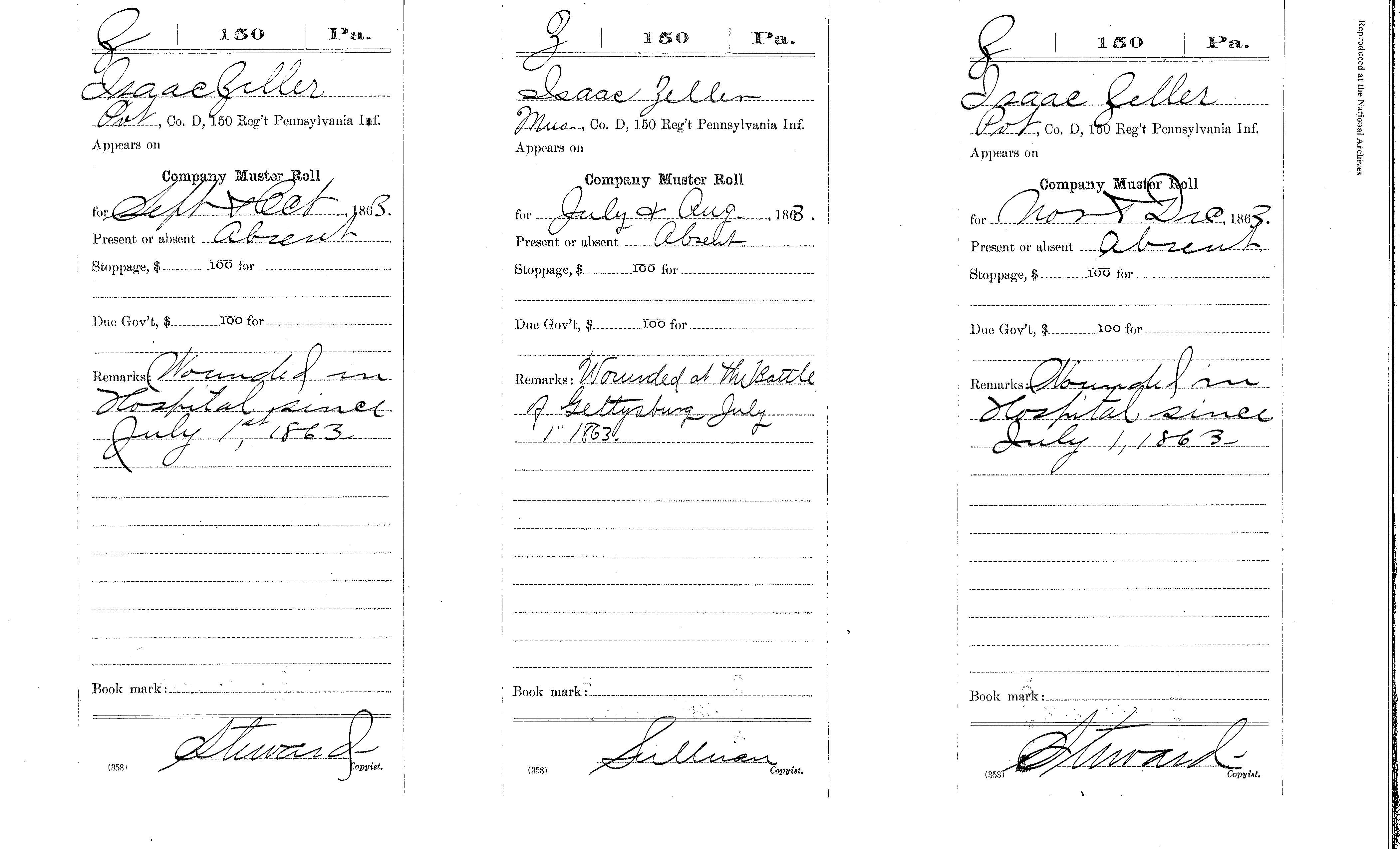
This is page that shows that he was wounded at the Battle of Gettysburg
Another military record came today for my wife's great-great-great-grandfather, Rufus Black, who was killed in battle in Louisiana.
"Rufus Black, a Corporal of Captain C. Dolan's Company K of the 2nd Regiment of Veterans Calvary Volunteers of the State of New York, born in Hadley, State of New York, age 28 years; 5 feet 11 inches high; dark complexion, black eyes, and black hair, and by occupation a farmer, having joined the company on its original organization at Stony Creek, and enrolled in it at the muster into the service of the United States at Saratoga, NY, on the 10 day of November 1863 … to serve in the Regiment, for the full term of three years.
He died June 27 1864 at Barracks General Hospital New Orleans La. of contusions in left side from fall of horse in action at Campti La. April 4, 1864.
Actions:
Compti, LA Apr 4 1864
Pleasant Hill, Apr 9 1864
Cane River Ford (Battle of Monnet's Ferry), Apr 24, 1864
One of the documents noted his personal effects with him at the time of his death:
blankets – two
overcoat – one
shirts – one
drawers – one
boots – one
cap – one
wallet – one
medals – one
beads – one string
diary book – one
This is one of the documents in the military record:
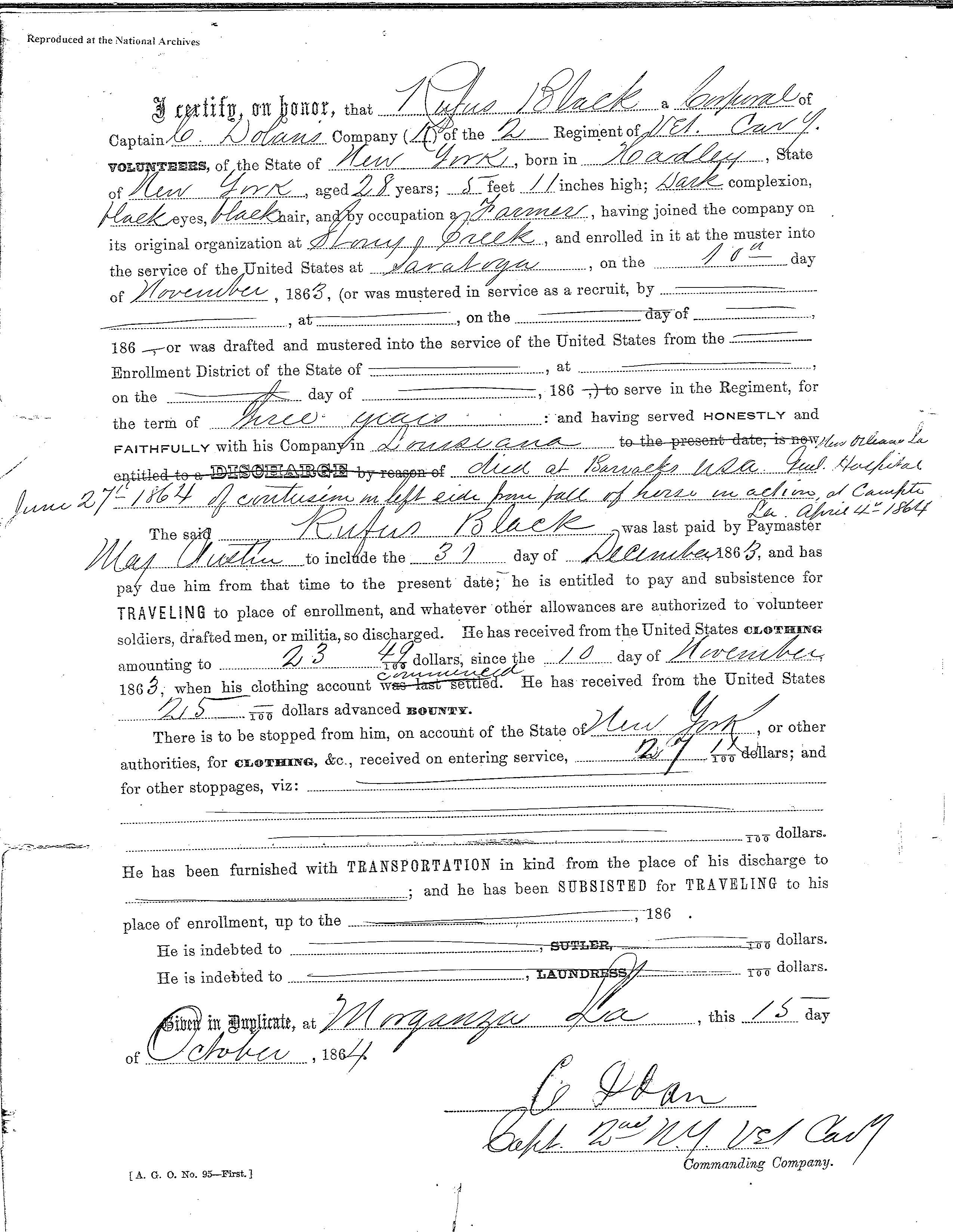
Two letters arrived from Serradifalco, Sicily today. One had birth certificates for me and my two sons and the marriage certificate for me and my wife. The other had AIRE documents for me and my two sons; the AIRE is the registry for Italian citizens living abroad. It's now officially official. We are Italian citizens.
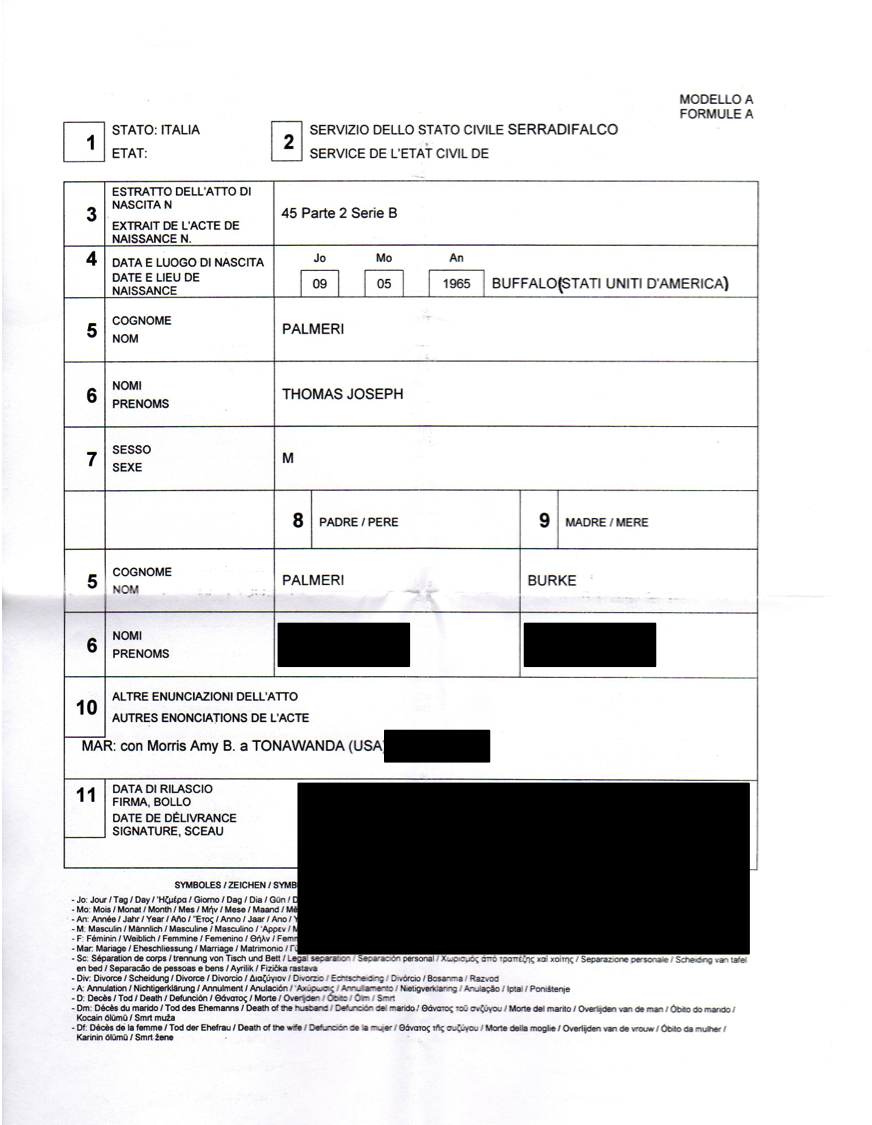
my Italian birth certificate (redacted of course)

our marriage certificate (redacted)
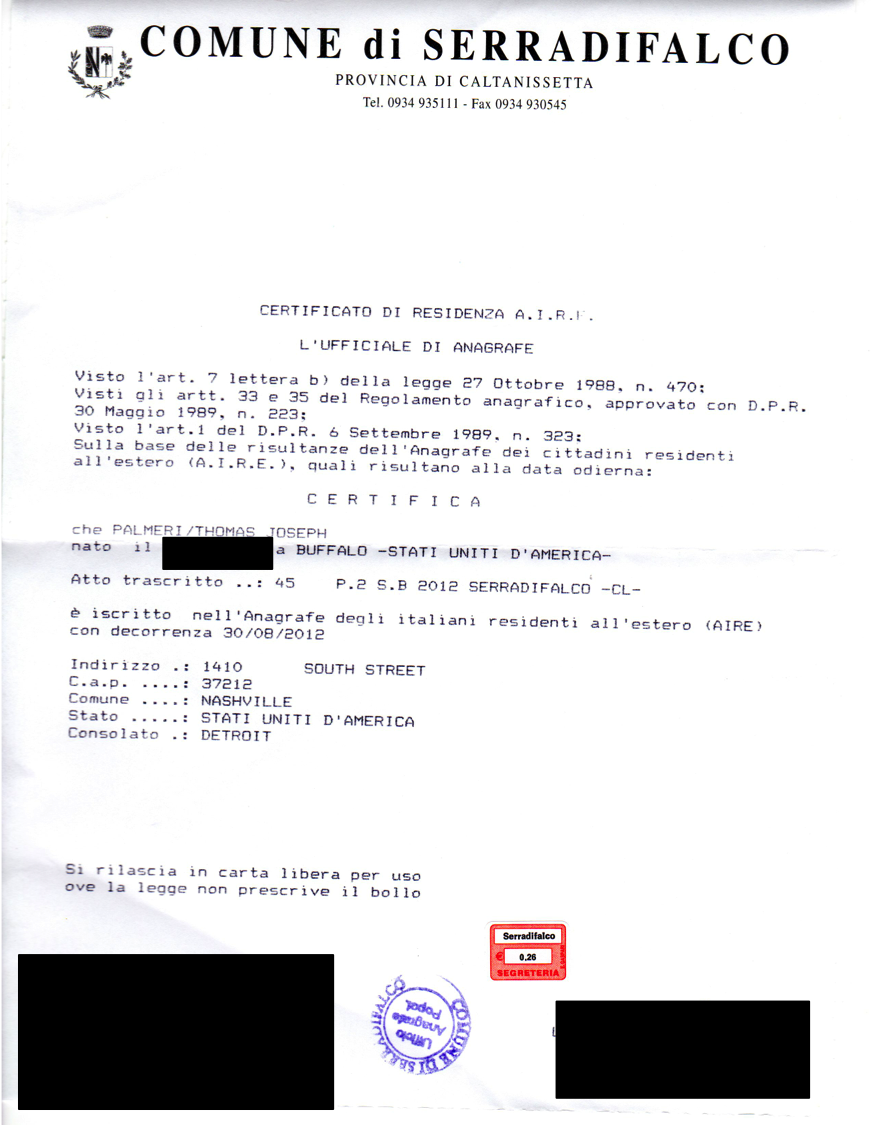
my AIRE registration as an Italian citizen living abroad
My wife's great-great-great-grandfather was Rufus Black. He was born 22 Jan 1836 and was killed during the Civil War on 27 Jun 1864. I ordered his Civil War Pension records from the National Archives to see if they might have more information on him and his parents.
Rufus Black was enrolled 12 Oct 1863 in Company K of the 2nd New York Veterans Calvalry, to serve for 3 years or during the war. He was mustered into service as a private on 10 Nov 1863 in Saratoga, NY.
On the muster roll of Company K of that Regiment, for the months of July and August, he is reported to have died June 27, 1864 in hospital at New Orleans by fall of his horse in action April 4, 1863 near Camptri, Louisiana.
While unfortunately this record does not reveal much more about Rufus's family. It does note a witness named "Hiram Black" who I had as Rufus's father. It also notes another witness with the last name of "Wait" which provides some additional evidence that Clarintha (Bloss) Black, Rufus's wife, is the child of Joseph Potter and Nancy Wait – this "Wait" as a witness could be her cousin perhaps.
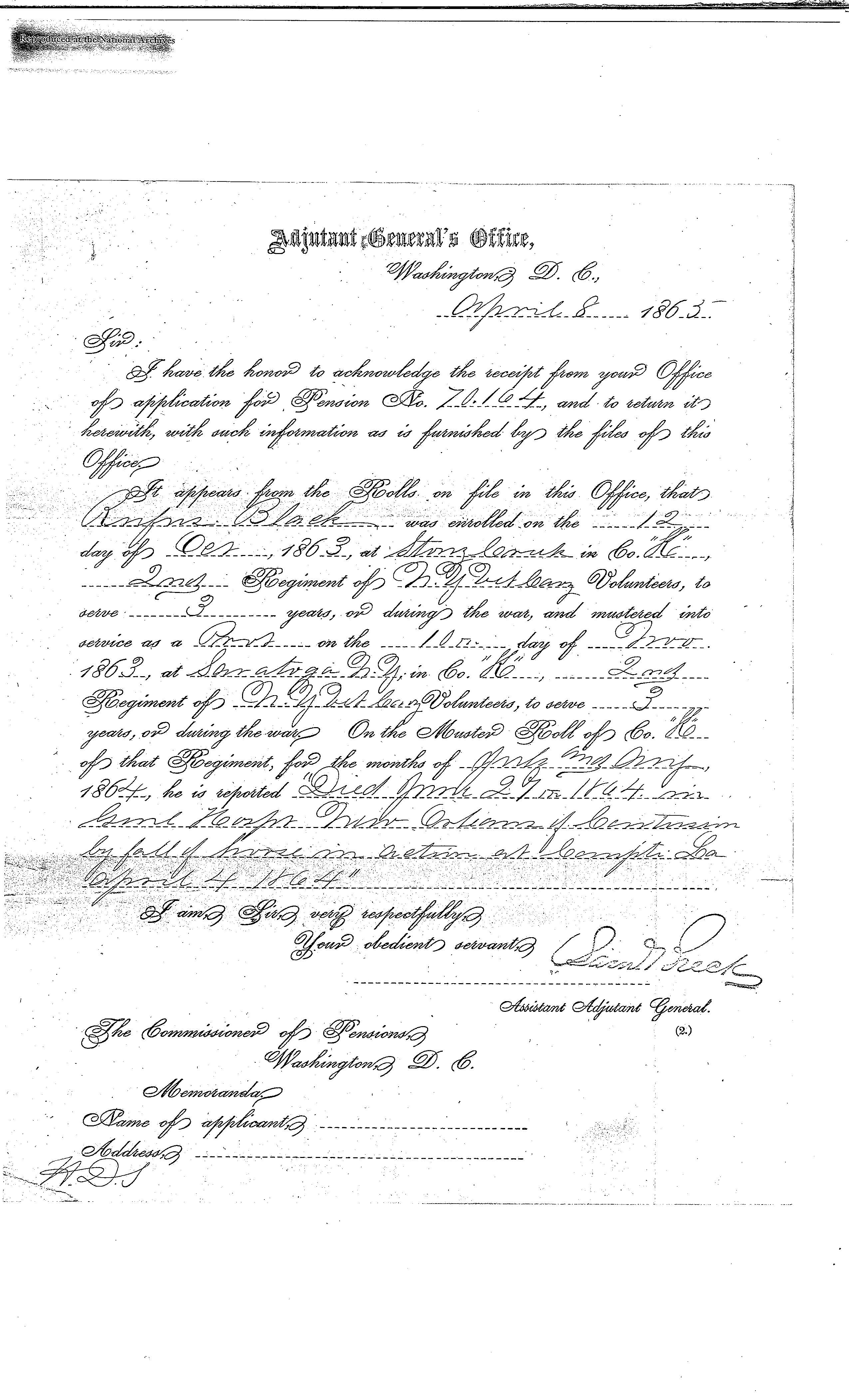
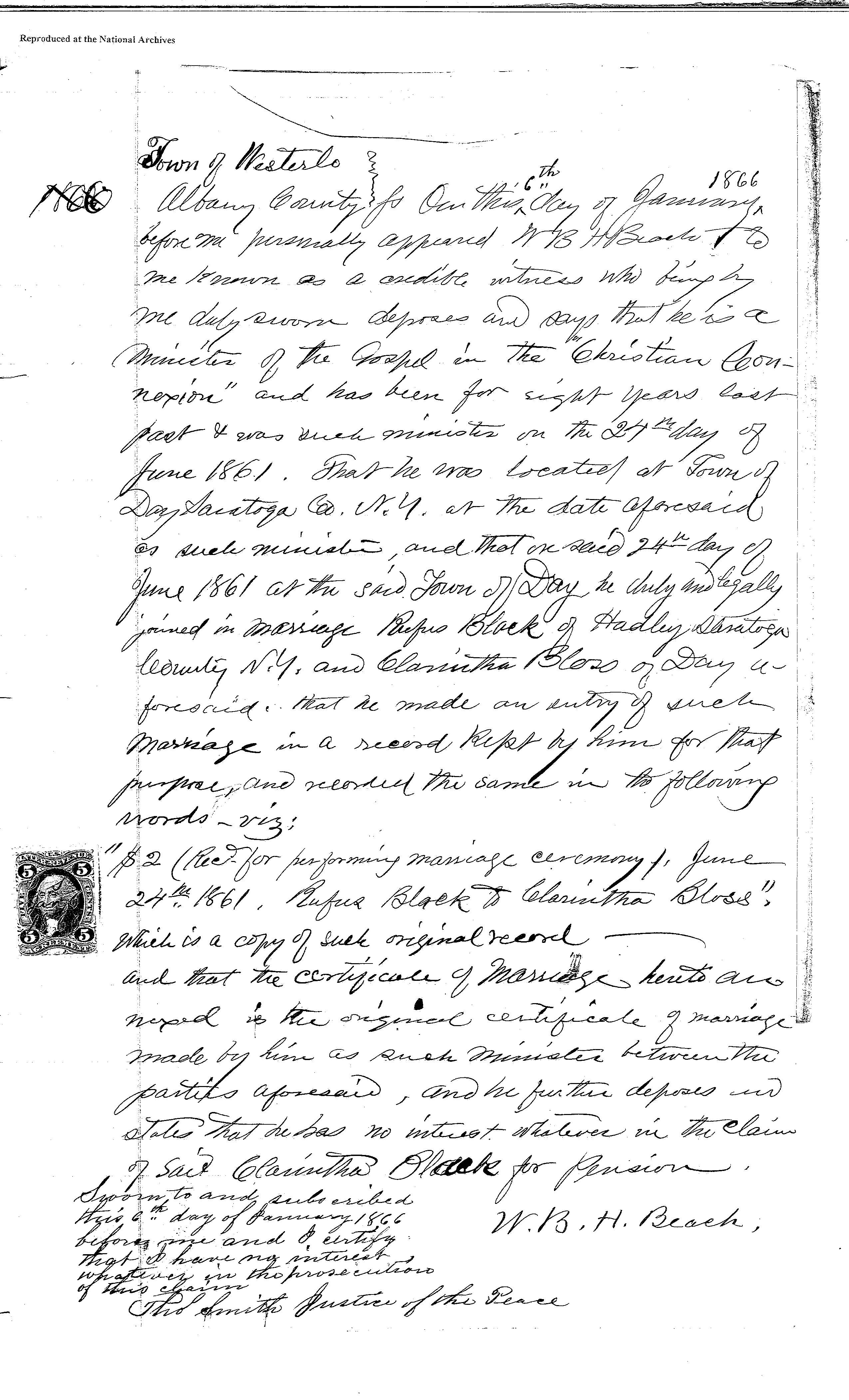
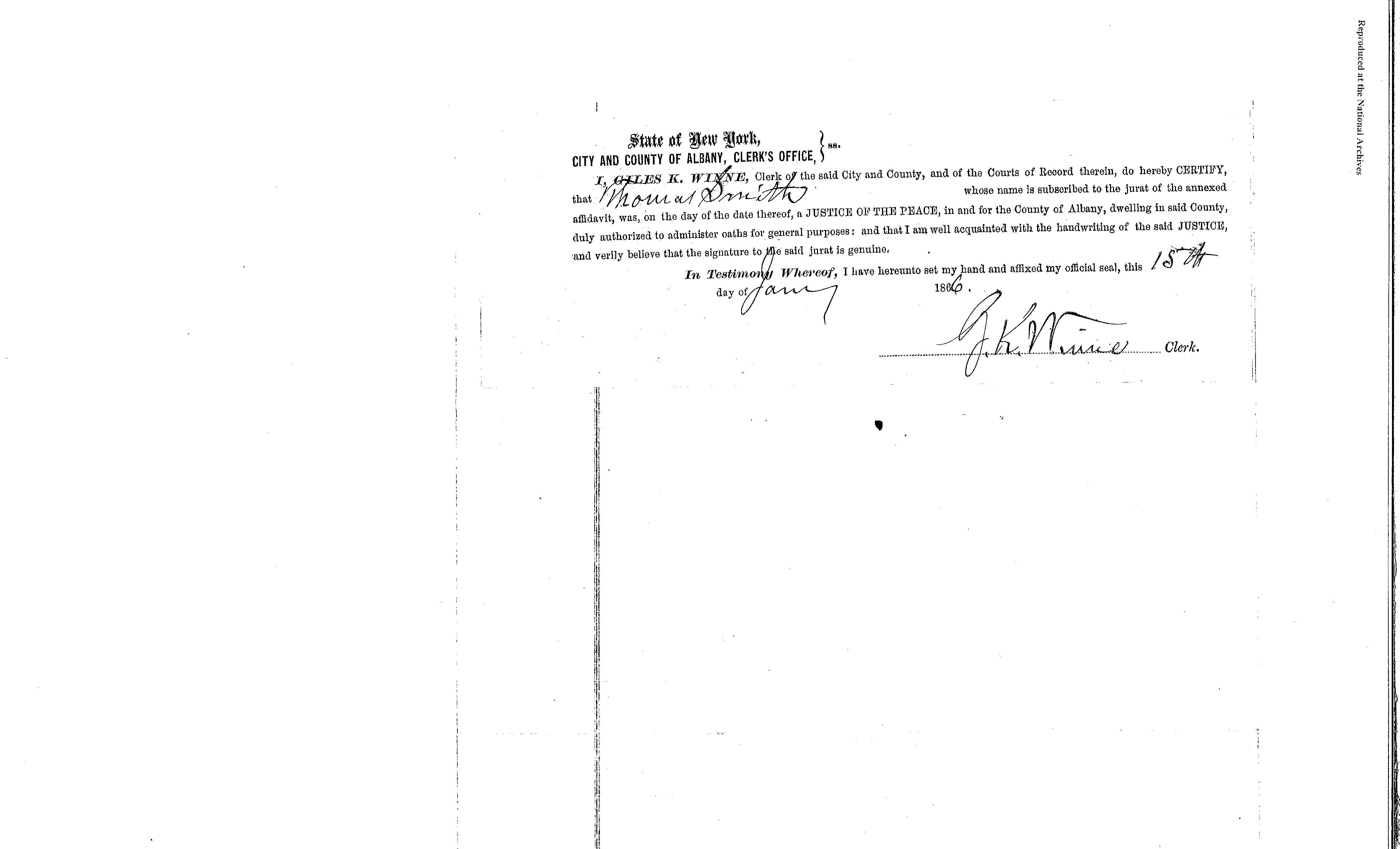
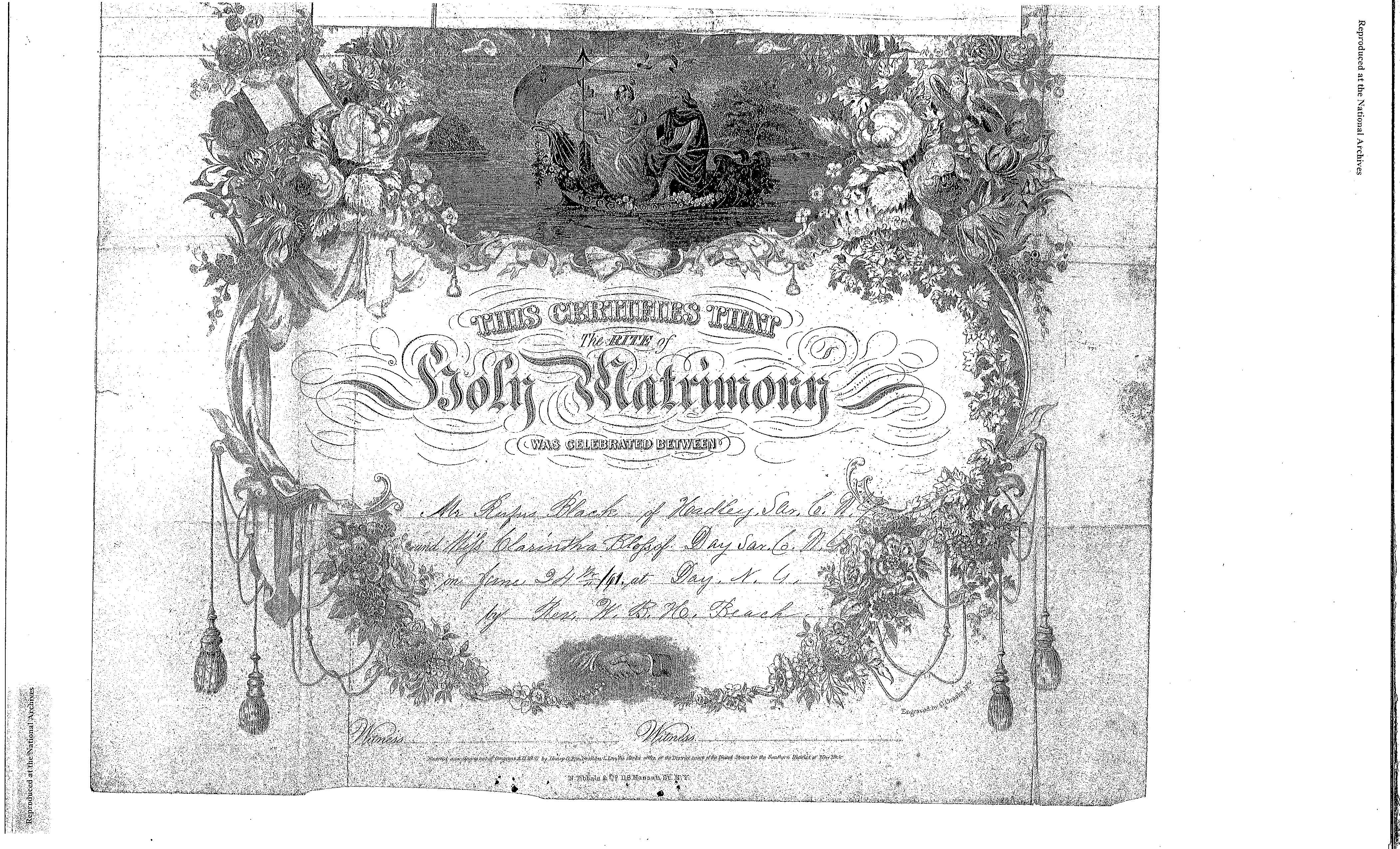
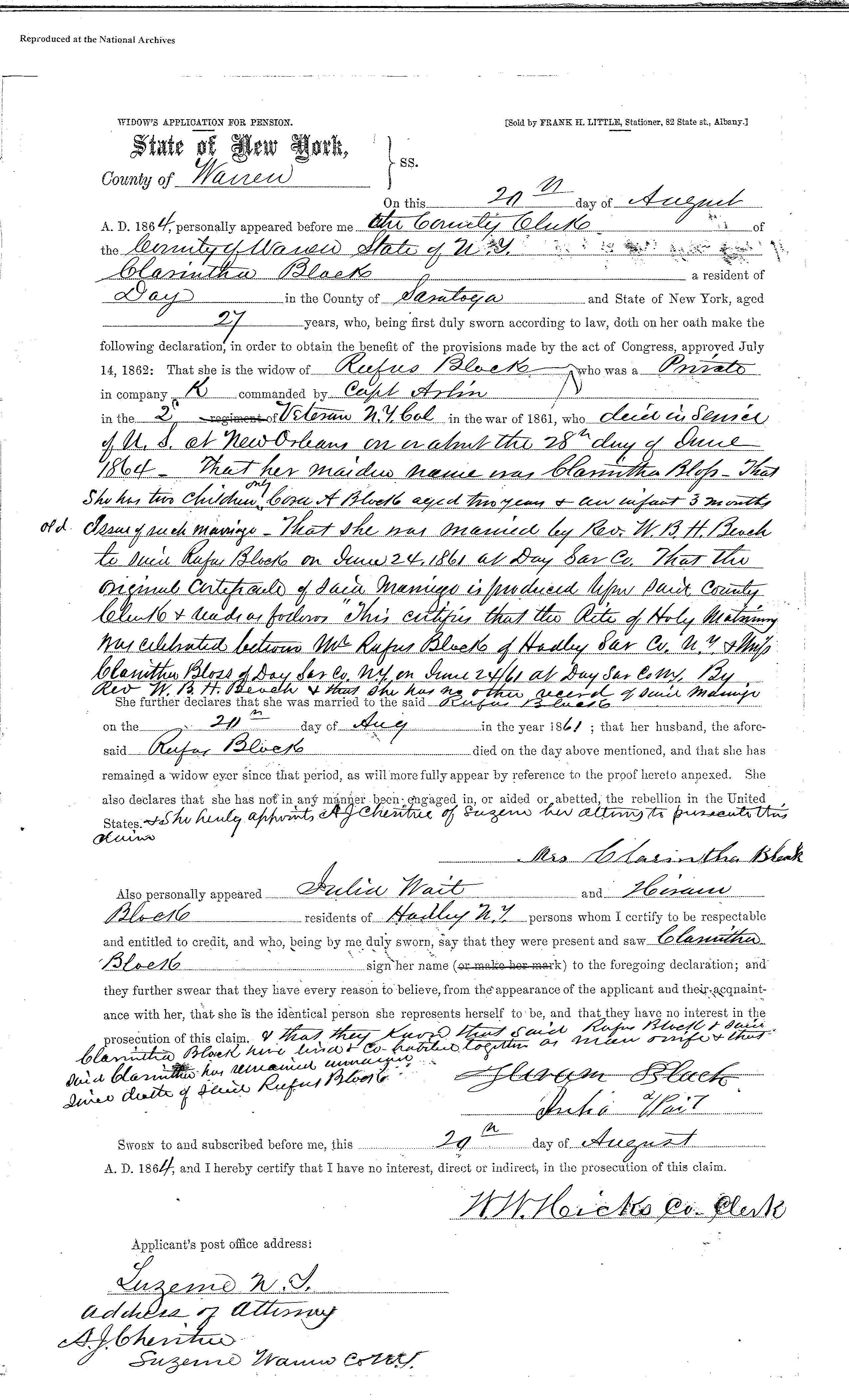

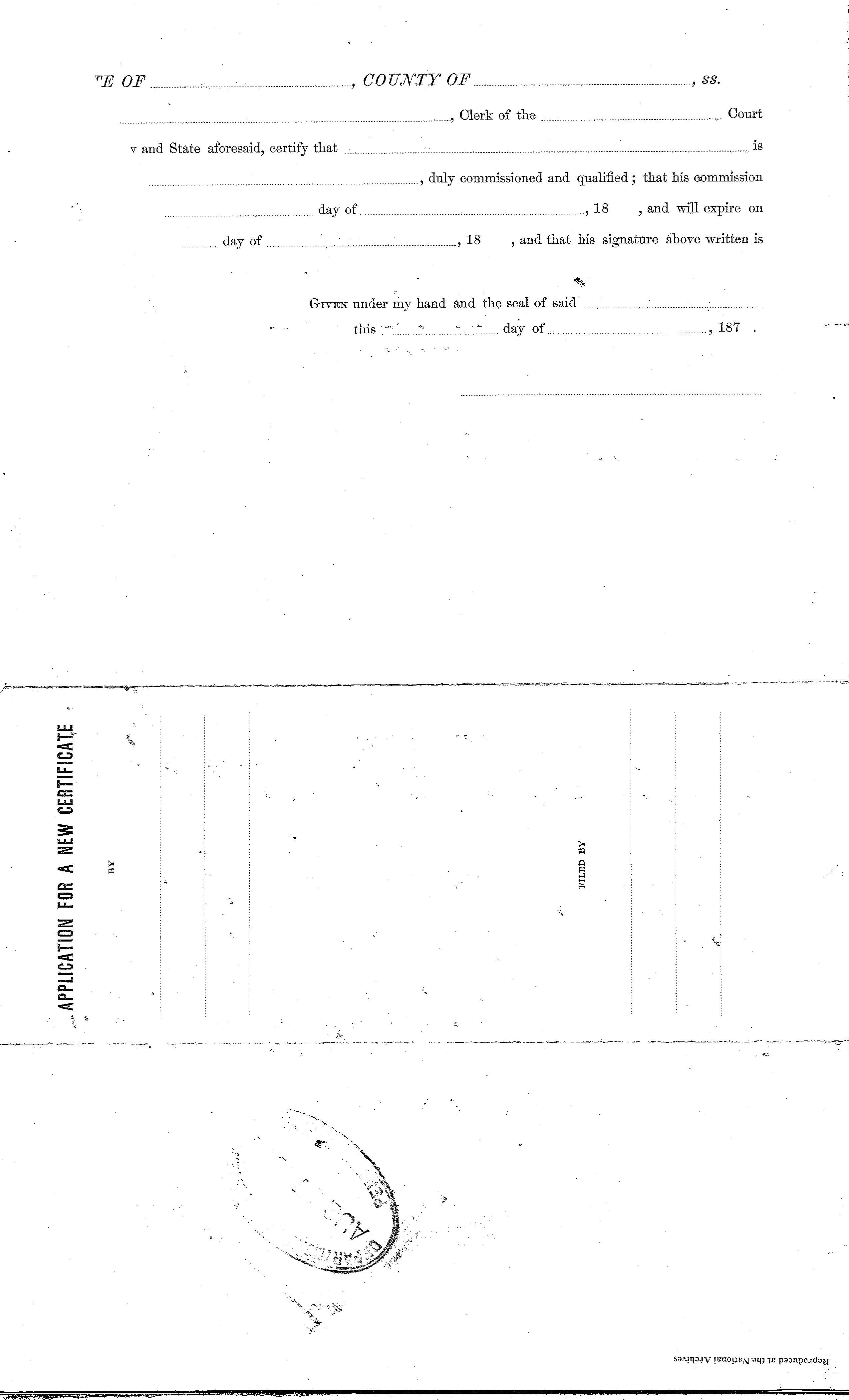
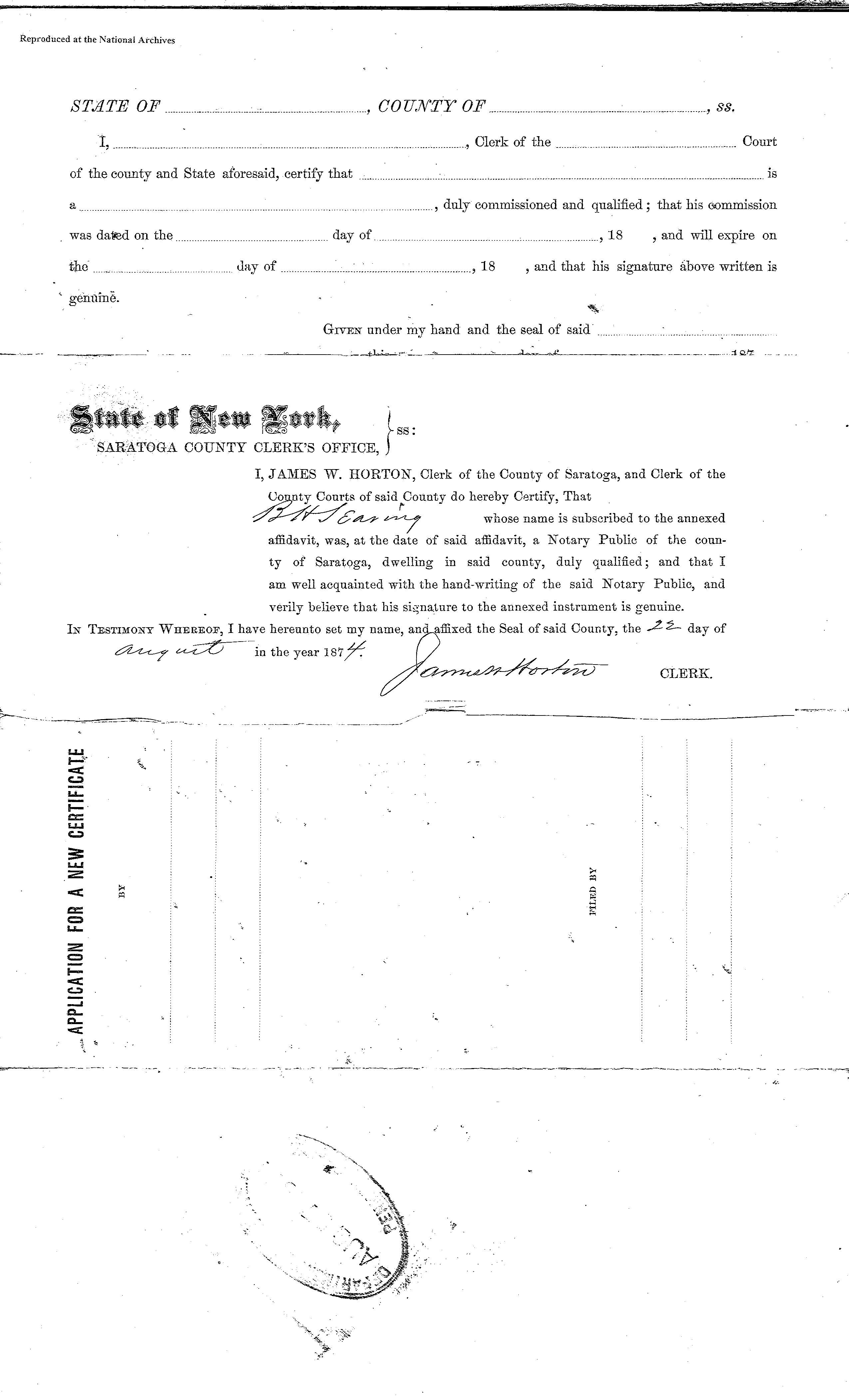
Until a year ago, I did not know that my great-grandfather had two other brothers, Salvatore and Pietro. While I have been able to put together a list of their children from the 1920 and 1930 census records, I had no information about who their children married and who their children were.
In part to flesh out the family tree, and in part to be able to share my findings with other Palmeris, I sent about 20 letters out to Palmeris living in and around Buffalo, I told them about the family tree I was putting together and I provided the information I have about the Palmeri family.
In the past two days, I have gotten emails from one of Pietro's grandchildren and one of Salvatore's grandchildren. Both were willing to work with their cousins to fill out the Palmeri family tree.
Yesterday, my cousin Elyse sent me some great photos of the Millonzi family that she got from her great-grandmother, Concetta, my great-grandfather's sister.
Back Row (left to right): (1) unknown woman, (2) probably Concetta (Millonzi) Fiorella (1896-1994), (2) probably another Millonzi sister (possibly Lillie or Carmela), (3) unknown man, (4) family donkey. Middle Row (left to right): (1) Rosario Millonzi (1887-1971), (2) unknown, (3) Ignazio Millonzi (1846-), (4) possibly Phillip Millonzi. Front Row (left to right): (1) probably Giuseppe Millonzi (1873-), (2) Ignazio Millonzi (1884-1977), (3) unknown man and child, (4) Rosaria Salemi (1853-), (5) unknown woman.
Back Row (left to right): (1) Rosaria Millonzi (1887-1971), (2) unknown man, (3) unknown man, (4) probably Giuseppe Millonzi (1873-). Middle Row (left to right): (1) probably Concetta (Millonzi) Fiorella (1896-1994), (2) Ignazio Millonzi (1884-1977), (3) probably another Millonzi sister (possibly Lillie or Carmela), (4) Rosaria Salemi (1853-). Front Row (left to right): (1) possibly Phillip Millonzi, (2) unknown woman, (3) unknown woman and child, (4) Ignazio Millonzi (1846-).

Ignazio Millonzi (1884-1977)
Rosaria Salemi (1853-)
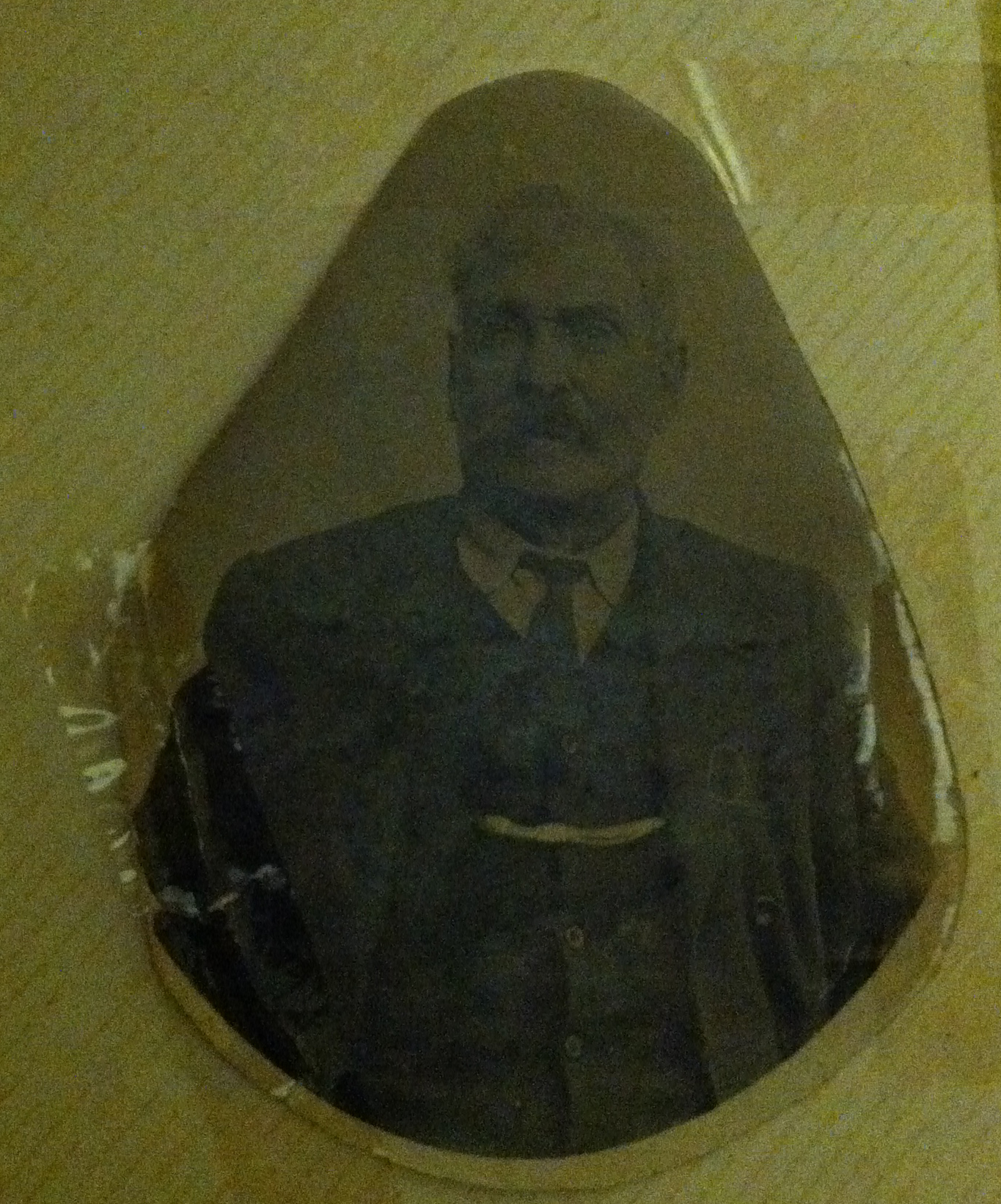
Ignazio Millonzi (1846-)
My great-grandfather was a prisoner of war during WWI. He was captured during the the retreat from the Battle of Caporetto in northeast Italy and was a prisoner of war for 14 months in an Austro-Hungarian or German camp. According to family lore, he was so hungry he had to eat his shoes. My great-grandmother's family heard nothing of him after his capture. Her brother was a monseigneur and was able to get someone from the Vatican to track him down and check on him in the camp. When the Germans found out that my great-grandfather was a tailor, they took him off hard labor and had him make clothes for the officers. Soon after he was released, he emigrated to the US.
Someone suggested contacting the International Red Cross: http://www.icrc.org/eng/resources/icrc-archives/index.jsp
Perhaps they have a record of him? It'll take 6-12 months to get a response.
Update 5 Sep 2012
The IRC is digitizing their records. So no requests can be made until 2014.
http://www.icrc.org/eng/resources/documents/article/other/archives-first-world-war-2011-07-27.htm
I ordered the military service records from the Italian archives in Palermo for my great-grandfather, Rosario Millonzi. He fought for Italy during World War I and was a prisoner of war (captured by the Germans and Austrians). Here is the letter I used to order them:
Achivo di Stato di Palermo
Corso Vittorio Emanuele 31
90133 Palermo
Italy
Mi dispiace. Scrivo un po' italiano.
Mi potete aiutare a trovare i record militari per il mio bisnonno?
Il mio bisnonno, Rosario Millonzi, è nato 27 settembre 1887 in Montemaggiore Belsito, Provincia di Palermo. La sua moglie era Carmela Parisi. I suoi genitori erano Ignazio Millonzi e Rosaria Salemi.
Ha combattuto nella WWI (prima guerra mondiale). Era un prigioniero di guerra.
Potete inviare i suoi documenti militari?
Ho incluso una copia del mio passaporto. Avete bisogno di altro?
Grazie mille.
Update 4 Sep 2012
Here is the response I received. Basically, it tells me to try this other office.
In merito alla sua richiesta, si comunica che presso questo Archivio non si conservano le liste di leva relative al comune e all'anno da lei indicati. Ad ogni modo può chiedere il foglio matricolare del suo bisnonno al seguente ufficio:
Comando Regionale Militare Sud
Centro Documentale di Palermo
Piazza Indipendenza, 7
90129 Palermo
Fax: 091 6453601 – 1673601
e-mail: cedoc_Palermo@esercito.difesa.it
Today I ordered Civil War and Revolutionary War documents for several ancestor's in my wife's family tree. If they come back, some might confirm the names of their parents, while others may reveal the names of their parents.
Sites
http://www.archives.gov/veterans/military-service-records/
http://www.archives.gov/veterans/military-service-records/pre-ww-1-records.html
Civil War
Henry Angle (1841-1926), parents unknown
Rufus Black (1836-1864), probably died in battle outside of New Orleans, parents probably Hiram and Polly but uncertain, also ordered pension file
Isaac Zeller (1839-1912), uncertain about his parents
Revolutionary War
Joseph Gallup (1725-1778), possible service in Revolutionary War, possibly died during battle
Copied from a post made to the Italian Dual Citizenship message board:
Here's a reasonably complete list of the geographic places where Italian citizens have the right to live and/or pursue their (legal) livelihoods. If you have any corrections or additions, please send me a private message and, if possible, include a citation.
Austria
Belgium
Bulgaria
Croatia (as of July, 2013)
Cyprus
Czech Republic
Denmark (excluding Greenland and the Faroe Islands)
Estonia
Finland (with limitations in Åland)
France (including most of its overseas territories)
Germany
Greece (effectively excluding Mount Athos)
Hungary
Iceland
Ireland
Italy
Latvia
Liechtenstein
Lithuania
Luxembourg
Malta
Netherlands (including its overseas territories)
Norway
Panama*
Poland
Portugal (including its overseas territories)
Romania
Slovakia
Slovenia
Spain (including its overseas territories)
Sweden
Switzerland
United Kingdom (excluding many of its overseas territories)
The Vatican (subject to the Holy See's decisions)
* Panama?
I just stumbled across another interesting dimension to Italian citizenship. In the 1960s, Italy and Panama signed a "Treaty of Friendship, Commerce, and Navigation." (I'm trying to find a direct link to the treaty, but I haven't found it yet.) That treaty grants Italian citizens permission to live and work in Panama indefinitely and without too much hassle. As far as I can tell Italians are unique among foreigners in being granted this special permission in Panama.
According to this law firm, you need to supply the following:
three photos
copy of your passport, notarized by a Panamanian official
criminal record (original country or country where resident)
medical certificate of good health (dated within 3 months)
payment (about US$250)
sworn declaration of personal background
document showing the purpose of permanent residence (e.g. business interest)
proof of economic solvency
Once approved, an Italian citizen can live and work in Panama as long as desired.
There was about a 14 month period (February, 2008, to April, 2009) when this treaty right was suspended, but according to what I can find this treaty right has been restored and is currently available.
Counting Panama, Italian citizens can live and work indefinitely in 32 countries. And I'm not done searching yet, so perhaps I will find more.
I'm not sure why Panama granted this permission to Italians particularly, but there it is.
Monsignor Mercurio Maria Teresi was born in Montemaggiore in 1742 and is somewhere in the early stages of being considered for sainthood by the Catholic church. My great-grandfather Rosario Millonzi's grandmother was a Filippa Teresi born in 1813. We could be related to a future saint.
We learned this visiting Montemaggiore Belsito, home town of Rosario Millonzi, my great-grandfather, and Carmela Parisi, my great-grandmother. My grandmother and my uncle were also born there soon before they all emigrated to the US in 1920.
According to http://www.monsignorteresi.it, with the help of google translate, he was born 10 October 1742 to Cruciano Teresi and Margaret De Nasca in Montemaggiore Belsito. Two of his uncles, Don Antonio and Don Philip Teresi, were priests. He apparently showed singular piety, but was denied study to the priesthood because he seemed dull of mind. But after constant prayer before the statue of Our Lady, it was said that she laid her hand on the back of his head and he received such an intellect that at 18 years of age he had written his first work on the Immacolate Conception of Mary, followed from another book written at 20 years of age. He undertook and completed his studies in theology at the Jesuit Collegio Massimo of Palermo. In April 1765 he was ordained priest by the Bishop of Cefalu and immediately returned to the diocese and was appointed Spiritual Director and Professor of Moral Theology at the Episcopal Seminary of Cefalu. Two years later he left the Chair and the seminary to pursue priesthood with all the enthusiasm to the Saints missions. He spent nearly forty years of his life evangelizing the vast Diocese of Sicily. First he went to Nicosia, where he stayed for a whole month, then reached Mazzarino, Newfoundland, Sperlinga, Palermo, Messina, Catania, Siracusa, Agrigento, Mazara, Monreale, Palermo, etc.. He paid this feat with great sacrifices, hardships, dangers and misunderstandings of all kinds. Although overwhelmed by the apostolic work, he learned the value of spare time in order to write and publish various works of a theological, ascetics, enriched by historical thoughts and lessons learned from the Fathers and Doctors of the Church and the texts of Sacred Scripture. In 1797 he was appointed parish priest of Montemaggiore Belsito for about 5 years. The fame of sanctity reached the ears of King Ferdinand III of Bourbon and his wife Queen Caroline who wanted him to attend their court as a preacher and confessor, recognizing in him the man of God who spread the word and works with the "bonus odor Christi ". Ferdinand III was captivated by his words and example of his life. Bishop Teresi, spiritually linked by a great affection to the Society of Jesus, said the return of the Jesuits in Sicily and also the restoration of the Archdiocese of Monreale, abolished in 1775. Both the favors were granted in 1803 and in obedience to the Pope and the King accepted the post of bishop of Monreale. Although the charge did not alter his style of apostolic life, continuing to favor the poor. He led with firmness and gentleness, the archdiocese and died April 18, 1805 in Monreale. Tradition says that in the same hour in which he died (the 2 am) the bells of the parish church of Montemaggiore Belsito, which he had raised to a minor basilica, gave themselves the announcement of his death. "The fame of holiness of Mary Teresi Mercury" as said by Pope Pius XI in the Papal Bull with which raised the Monreale Cathedral Basilica Minore 28 August 1926 "in recent times has increased and extended everywhere."
